Australian Diabetes Strategy's Impact on Nursing Practice, NURSING 5
VerifiedAdded on 2022/08/20
|10
|2717
|11
Essay
AI Summary
This essay provides an in-depth analysis of the Australian National Diabetes Strategy 2016-2020, examining its profound impact on nursing practice and the broader healthcare system. The paper explores how the policy influences nursing roles in diabetes prevention, early detection, and patient management, with a focus on culturally appropriate care, education, and nutritional counseling. The analysis highlights specific goals and actions within the strategy, such as improving workforce capacity, implementing innovative technologies, and addressing the needs of priority groups, including Aboriginal Australians and pregnant women. Furthermore, the essay assesses the strategy's contribution to strengthening the Australian health system's response to diabetes, emphasizing the integration of technology for screening and patient management. The essay concludes by emphasizing the strategy's effectiveness in enhancing professional competency among nurses and driving positive reforms in the healthcare landscape, ultimately aiming to reduce the burden of diabetes within the community.
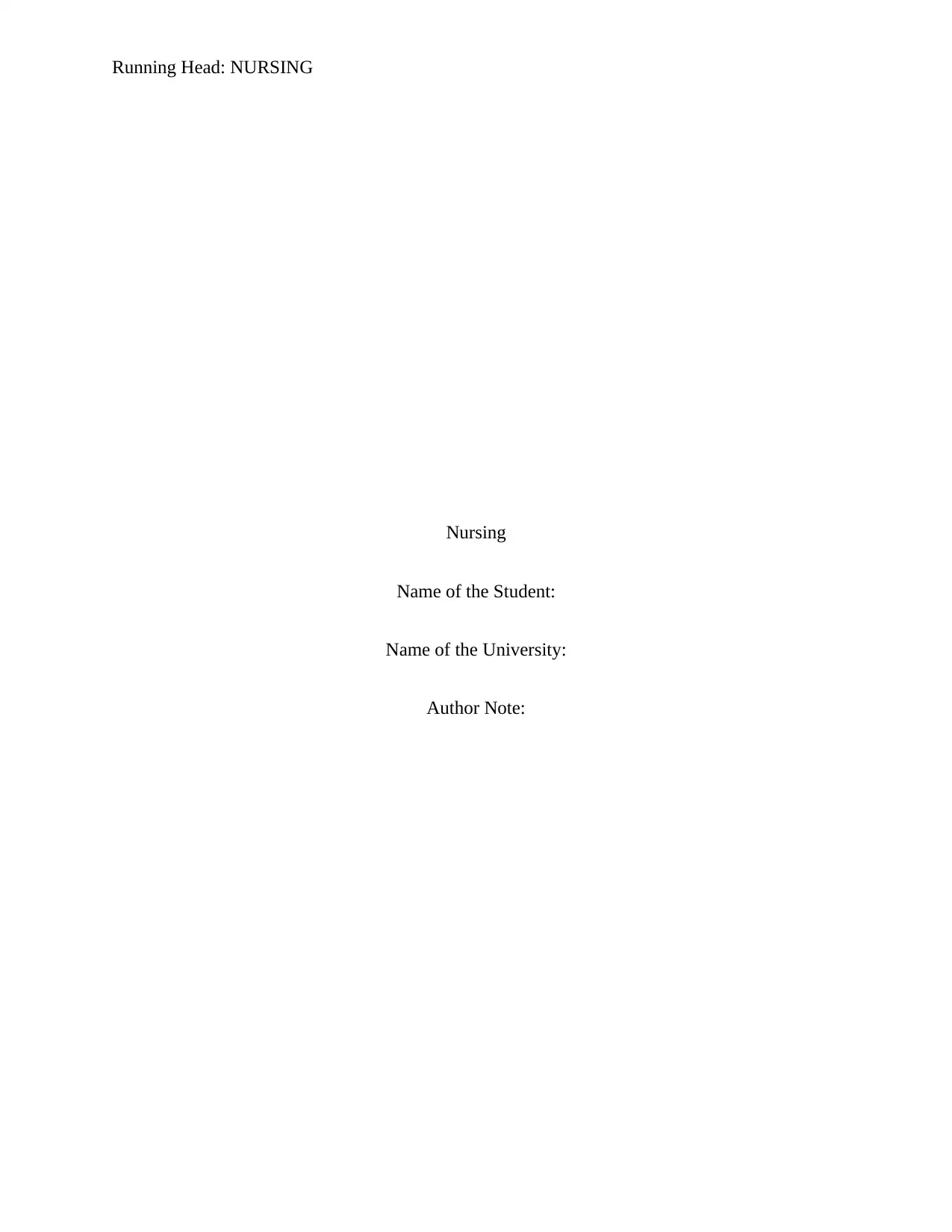
Running Head: NURSING
Nursing
Name of the Student:
Name of the University:
Author Note:
Nursing
Name of the Student:
Name of the University:
Author Note:
Paraphrase This Document
Need a fresh take? Get an instant paraphrase of this document with our AI Paraphraser
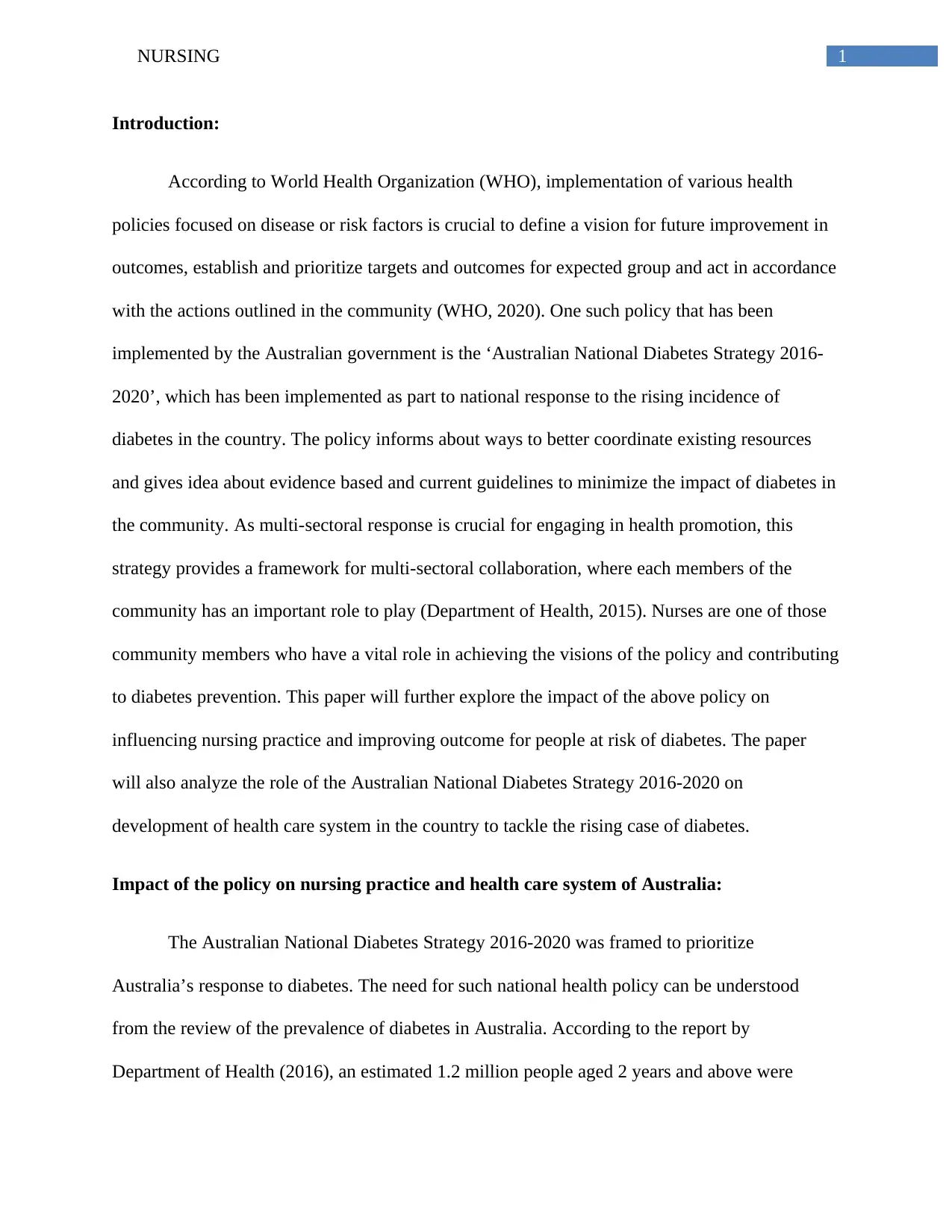
1NURSING
Introduction:
According to World Health Organization (WHO), implementation of various health
policies focused on disease or risk factors is crucial to define a vision for future improvement in
outcomes, establish and prioritize targets and outcomes for expected group and act in accordance
with the actions outlined in the community (WHO, 2020). One such policy that has been
implemented by the Australian government is the ‘Australian National Diabetes Strategy 2016-
2020’, which has been implemented as part to national response to the rising incidence of
diabetes in the country. The policy informs about ways to better coordinate existing resources
and gives idea about evidence based and current guidelines to minimize the impact of diabetes in
the community. As multi-sectoral response is crucial for engaging in health promotion, this
strategy provides a framework for multi-sectoral collaboration, where each members of the
community has an important role to play (Department of Health, 2015). Nurses are one of those
community members who have a vital role in achieving the visions of the policy and contributing
to diabetes prevention. This paper will further explore the impact of the above policy on
influencing nursing practice and improving outcome for people at risk of diabetes. The paper
will also analyze the role of the Australian National Diabetes Strategy 2016-2020 on
development of health care system in the country to tackle the rising case of diabetes.
Impact of the policy on nursing practice and health care system of Australia:
The Australian National Diabetes Strategy 2016-2020 was framed to prioritize
Australia’s response to diabetes. The need for such national health policy can be understood
from the review of the prevalence of diabetes in Australia. According to the report by
Department of Health (2016), an estimated 1.2 million people aged 2 years and above were
Introduction:
According to World Health Organization (WHO), implementation of various health
policies focused on disease or risk factors is crucial to define a vision for future improvement in
outcomes, establish and prioritize targets and outcomes for expected group and act in accordance
with the actions outlined in the community (WHO, 2020). One such policy that has been
implemented by the Australian government is the ‘Australian National Diabetes Strategy 2016-
2020’, which has been implemented as part to national response to the rising incidence of
diabetes in the country. The policy informs about ways to better coordinate existing resources
and gives idea about evidence based and current guidelines to minimize the impact of diabetes in
the community. As multi-sectoral response is crucial for engaging in health promotion, this
strategy provides a framework for multi-sectoral collaboration, where each members of the
community has an important role to play (Department of Health, 2015). Nurses are one of those
community members who have a vital role in achieving the visions of the policy and contributing
to diabetes prevention. This paper will further explore the impact of the above policy on
influencing nursing practice and improving outcome for people at risk of diabetes. The paper
will also analyze the role of the Australian National Diabetes Strategy 2016-2020 on
development of health care system in the country to tackle the rising case of diabetes.
Impact of the policy on nursing practice and health care system of Australia:
The Australian National Diabetes Strategy 2016-2020 was framed to prioritize
Australia’s response to diabetes. The need for such national health policy can be understood
from the review of the prevalence of diabetes in Australia. According to the report by
Department of Health (2016), an estimated 1.2 million people aged 2 years and above were
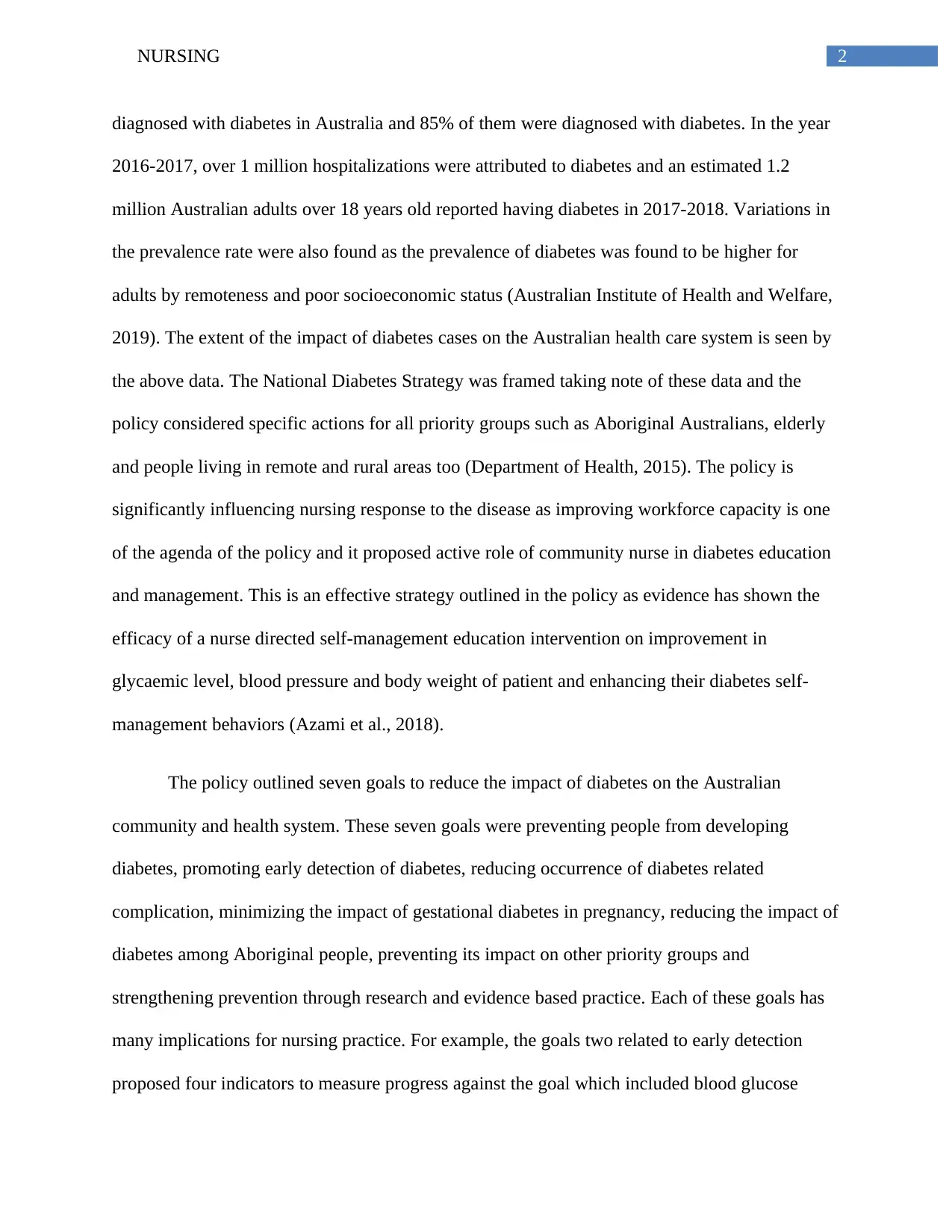
2NURSING
diagnosed with diabetes in Australia and 85% of them were diagnosed with diabetes. In the year
2016-2017, over 1 million hospitalizations were attributed to diabetes and an estimated 1.2
million Australian adults over 18 years old reported having diabetes in 2017-2018. Variations in
the prevalence rate were also found as the prevalence of diabetes was found to be higher for
adults by remoteness and poor socioeconomic status (Australian Institute of Health and Welfare,
2019). The extent of the impact of diabetes cases on the Australian health care system is seen by
the above data. The National Diabetes Strategy was framed taking note of these data and the
policy considered specific actions for all priority groups such as Aboriginal Australians, elderly
and people living in remote and rural areas too (Department of Health, 2015). The policy is
significantly influencing nursing response to the disease as improving workforce capacity is one
of the agenda of the policy and it proposed active role of community nurse in diabetes education
and management. This is an effective strategy outlined in the policy as evidence has shown the
efficacy of a nurse directed self-management education intervention on improvement in
glycaemic level, blood pressure and body weight of patient and enhancing their diabetes self-
management behaviors (Azami et al., 2018).
The policy outlined seven goals to reduce the impact of diabetes on the Australian
community and health system. These seven goals were preventing people from developing
diabetes, promoting early detection of diabetes, reducing occurrence of diabetes related
complication, minimizing the impact of gestational diabetes in pregnancy, reducing the impact of
diabetes among Aboriginal people, preventing its impact on other priority groups and
strengthening prevention through research and evidence based practice. Each of these goals has
many implications for nursing practice. For example, the goals two related to early detection
proposed four indicators to measure progress against the goal which included blood glucose
diagnosed with diabetes in Australia and 85% of them were diagnosed with diabetes. In the year
2016-2017, over 1 million hospitalizations were attributed to diabetes and an estimated 1.2
million Australian adults over 18 years old reported having diabetes in 2017-2018. Variations in
the prevalence rate were also found as the prevalence of diabetes was found to be higher for
adults by remoteness and poor socioeconomic status (Australian Institute of Health and Welfare,
2019). The extent of the impact of diabetes cases on the Australian health care system is seen by
the above data. The National Diabetes Strategy was framed taking note of these data and the
policy considered specific actions for all priority groups such as Aboriginal Australians, elderly
and people living in remote and rural areas too (Department of Health, 2015). The policy is
significantly influencing nursing response to the disease as improving workforce capacity is one
of the agenda of the policy and it proposed active role of community nurse in diabetes education
and management. This is an effective strategy outlined in the policy as evidence has shown the
efficacy of a nurse directed self-management education intervention on improvement in
glycaemic level, blood pressure and body weight of patient and enhancing their diabetes self-
management behaviors (Azami et al., 2018).
The policy outlined seven goals to reduce the impact of diabetes on the Australian
community and health system. These seven goals were preventing people from developing
diabetes, promoting early detection of diabetes, reducing occurrence of diabetes related
complication, minimizing the impact of gestational diabetes in pregnancy, reducing the impact of
diabetes among Aboriginal people, preventing its impact on other priority groups and
strengthening prevention through research and evidence based practice. Each of these goals has
many implications for nursing practice. For example, the goals two related to early detection
proposed four indicators to measure progress against the goal which included blood glucose
⊘ This is a preview!⊘
Do you want full access?
Subscribe today to unlock all pages.

Trusted by 1+ million students worldwide
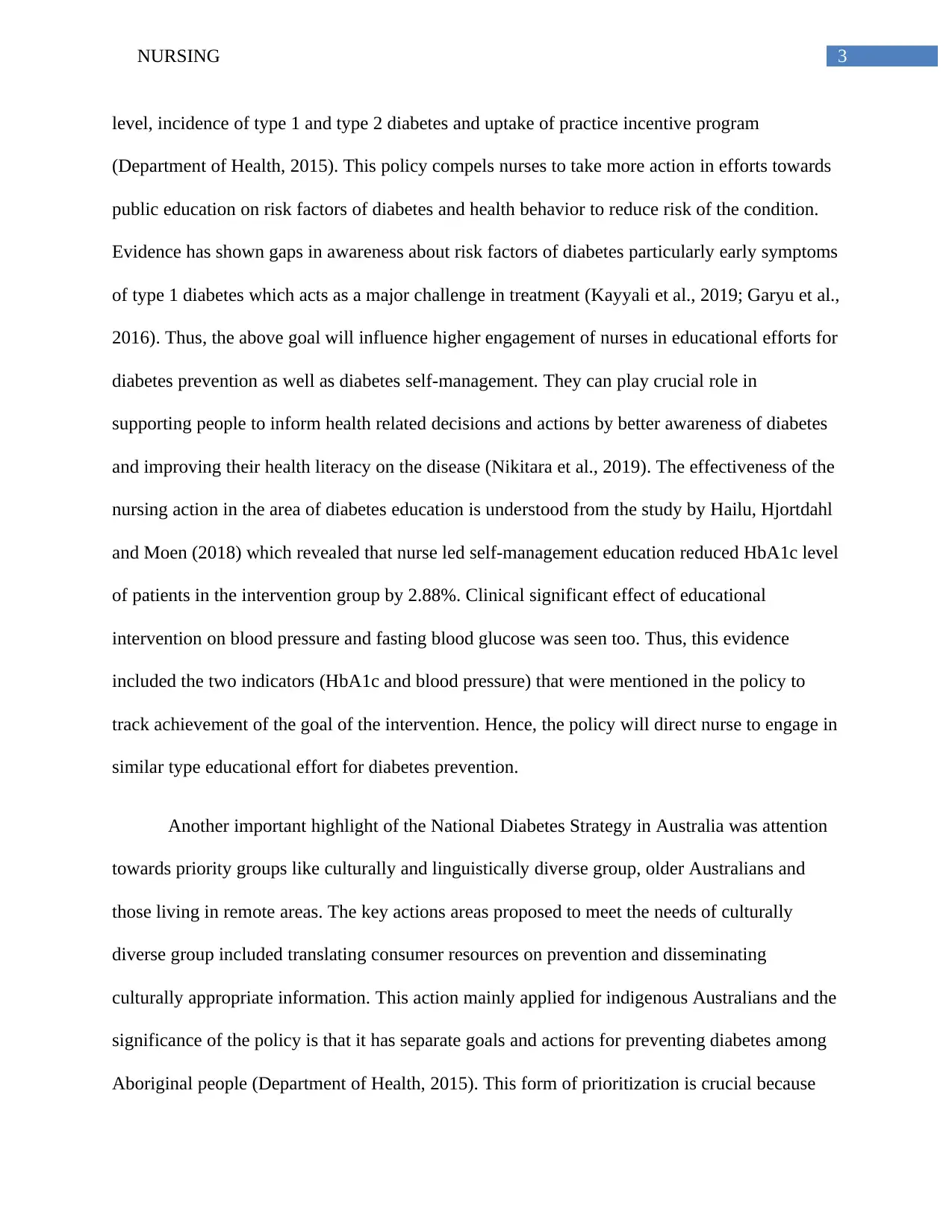
3NURSING
level, incidence of type 1 and type 2 diabetes and uptake of practice incentive program
(Department of Health, 2015). This policy compels nurses to take more action in efforts towards
public education on risk factors of diabetes and health behavior to reduce risk of the condition.
Evidence has shown gaps in awareness about risk factors of diabetes particularly early symptoms
of type 1 diabetes which acts as a major challenge in treatment (Kayyali et al., 2019; Garyu et al.,
2016). Thus, the above goal will influence higher engagement of nurses in educational efforts for
diabetes prevention as well as diabetes self-management. They can play crucial role in
supporting people to inform health related decisions and actions by better awareness of diabetes
and improving their health literacy on the disease (Nikitara et al., 2019). The effectiveness of the
nursing action in the area of diabetes education is understood from the study by Hailu, Hjortdahl
and Moen (2018) which revealed that nurse led self-management education reduced HbA1c level
of patients in the intervention group by 2.88%. Clinical significant effect of educational
intervention on blood pressure and fasting blood glucose was seen too. Thus, this evidence
included the two indicators (HbA1c and blood pressure) that were mentioned in the policy to
track achievement of the goal of the intervention. Hence, the policy will direct nurse to engage in
similar type educational effort for diabetes prevention.
Another important highlight of the National Diabetes Strategy in Australia was attention
towards priority groups like culturally and linguistically diverse group, older Australians and
those living in remote areas. The key actions areas proposed to meet the needs of culturally
diverse group included translating consumer resources on prevention and disseminating
culturally appropriate information. This action mainly applied for indigenous Australians and the
significance of the policy is that it has separate goals and actions for preventing diabetes among
Aboriginal people (Department of Health, 2015). This form of prioritization is crucial because
level, incidence of type 1 and type 2 diabetes and uptake of practice incentive program
(Department of Health, 2015). This policy compels nurses to take more action in efforts towards
public education on risk factors of diabetes and health behavior to reduce risk of the condition.
Evidence has shown gaps in awareness about risk factors of diabetes particularly early symptoms
of type 1 diabetes which acts as a major challenge in treatment (Kayyali et al., 2019; Garyu et al.,
2016). Thus, the above goal will influence higher engagement of nurses in educational efforts for
diabetes prevention as well as diabetes self-management. They can play crucial role in
supporting people to inform health related decisions and actions by better awareness of diabetes
and improving their health literacy on the disease (Nikitara et al., 2019). The effectiveness of the
nursing action in the area of diabetes education is understood from the study by Hailu, Hjortdahl
and Moen (2018) which revealed that nurse led self-management education reduced HbA1c level
of patients in the intervention group by 2.88%. Clinical significant effect of educational
intervention on blood pressure and fasting blood glucose was seen too. Thus, this evidence
included the two indicators (HbA1c and blood pressure) that were mentioned in the policy to
track achievement of the goal of the intervention. Hence, the policy will direct nurse to engage in
similar type educational effort for diabetes prevention.
Another important highlight of the National Diabetes Strategy in Australia was attention
towards priority groups like culturally and linguistically diverse group, older Australians and
those living in remote areas. The key actions areas proposed to meet the needs of culturally
diverse group included translating consumer resources on prevention and disseminating
culturally appropriate information. This action mainly applied for indigenous Australians and the
significance of the policy is that it has separate goals and actions for preventing diabetes among
Aboriginal people (Department of Health, 2015). This form of prioritization is crucial because
Paraphrase This Document
Need a fresh take? Get an instant paraphrase of this document with our AI Paraphraser
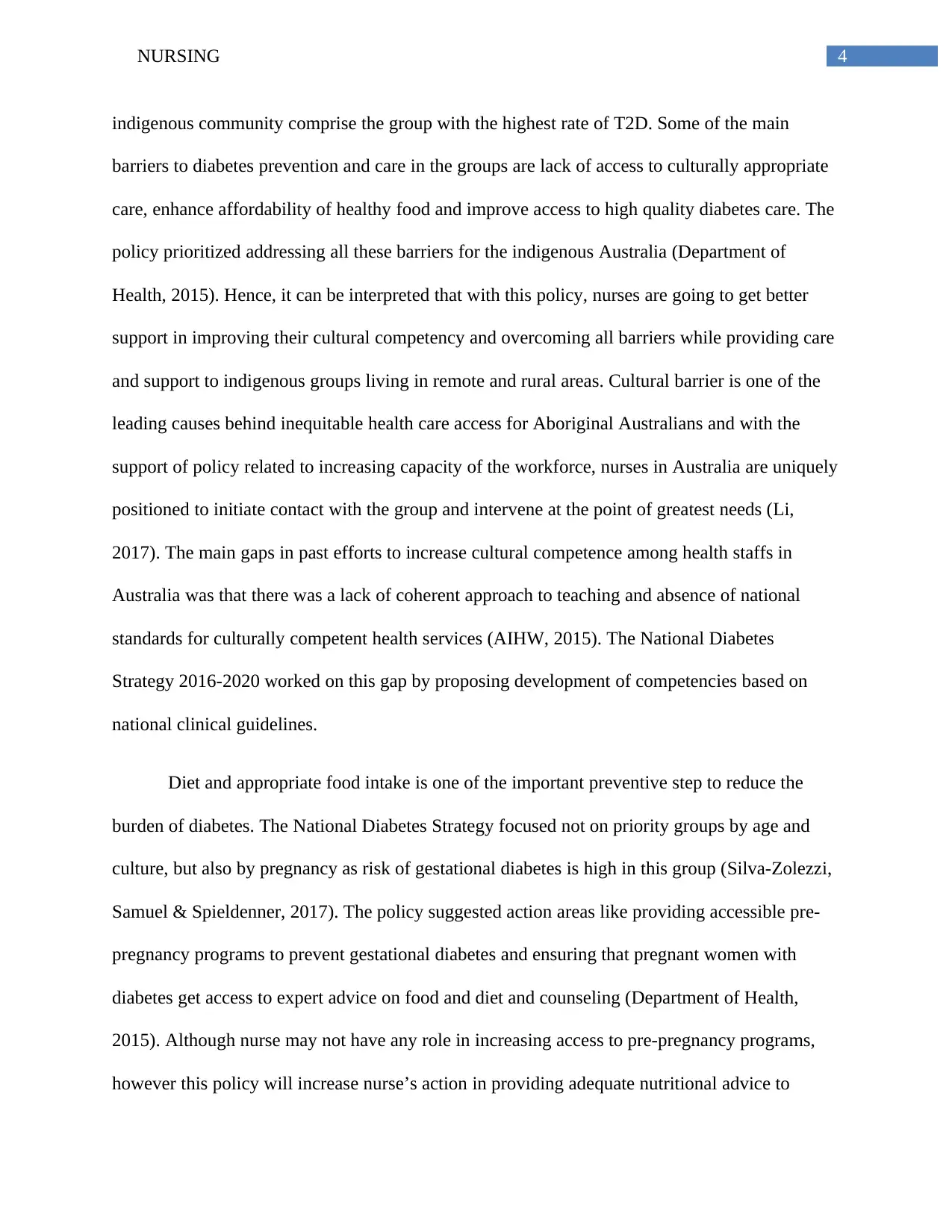
4NURSING
indigenous community comprise the group with the highest rate of T2D. Some of the main
barriers to diabetes prevention and care in the groups are lack of access to culturally appropriate
care, enhance affordability of healthy food and improve access to high quality diabetes care. The
policy prioritized addressing all these barriers for the indigenous Australia (Department of
Health, 2015). Hence, it can be interpreted that with this policy, nurses are going to get better
support in improving their cultural competency and overcoming all barriers while providing care
and support to indigenous groups living in remote and rural areas. Cultural barrier is one of the
leading causes behind inequitable health care access for Aboriginal Australians and with the
support of policy related to increasing capacity of the workforce, nurses in Australia are uniquely
positioned to initiate contact with the group and intervene at the point of greatest needs (Li,
2017). The main gaps in past efforts to increase cultural competence among health staffs in
Australia was that there was a lack of coherent approach to teaching and absence of national
standards for culturally competent health services (AIHW, 2015). The National Diabetes
Strategy 2016-2020 worked on this gap by proposing development of competencies based on
national clinical guidelines.
Diet and appropriate food intake is one of the important preventive step to reduce the
burden of diabetes. The National Diabetes Strategy focused not on priority groups by age and
culture, but also by pregnancy as risk of gestational diabetes is high in this group (Silva-Zolezzi,
Samuel & Spieldenner, 2017). The policy suggested action areas like providing accessible pre-
pregnancy programs to prevent gestational diabetes and ensuring that pregnant women with
diabetes get access to expert advice on food and diet and counseling (Department of Health,
2015). Although nurse may not have any role in increasing access to pre-pregnancy programs,
however this policy will increase nurse’s action in providing adequate nutritional advice to
indigenous community comprise the group with the highest rate of T2D. Some of the main
barriers to diabetes prevention and care in the groups are lack of access to culturally appropriate
care, enhance affordability of healthy food and improve access to high quality diabetes care. The
policy prioritized addressing all these barriers for the indigenous Australia (Department of
Health, 2015). Hence, it can be interpreted that with this policy, nurses are going to get better
support in improving their cultural competency and overcoming all barriers while providing care
and support to indigenous groups living in remote and rural areas. Cultural barrier is one of the
leading causes behind inequitable health care access for Aboriginal Australians and with the
support of policy related to increasing capacity of the workforce, nurses in Australia are uniquely
positioned to initiate contact with the group and intervene at the point of greatest needs (Li,
2017). The main gaps in past efforts to increase cultural competence among health staffs in
Australia was that there was a lack of coherent approach to teaching and absence of national
standards for culturally competent health services (AIHW, 2015). The National Diabetes
Strategy 2016-2020 worked on this gap by proposing development of competencies based on
national clinical guidelines.
Diet and appropriate food intake is one of the important preventive step to reduce the
burden of diabetes. The National Diabetes Strategy focused not on priority groups by age and
culture, but also by pregnancy as risk of gestational diabetes is high in this group (Silva-Zolezzi,
Samuel & Spieldenner, 2017). The policy suggested action areas like providing accessible pre-
pregnancy programs to prevent gestational diabetes and ensuring that pregnant women with
diabetes get access to expert advice on food and diet and counseling (Department of Health,
2015). Although nurse may not have any role in increasing access to pre-pregnancy programs,
however this policy will increase nurse’s action in providing adequate nutritional advice to
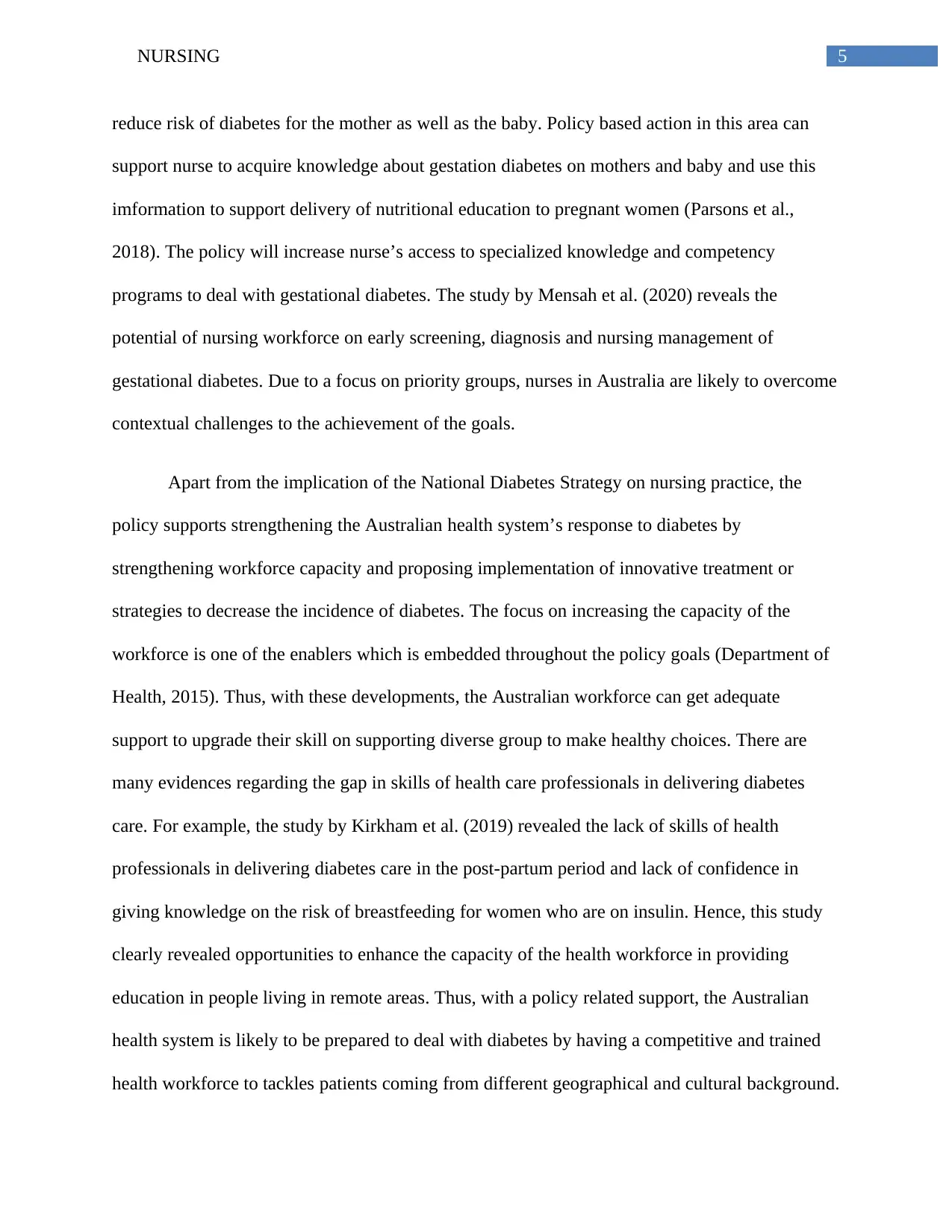
5NURSING
reduce risk of diabetes for the mother as well as the baby. Policy based action in this area can
support nurse to acquire knowledge about gestation diabetes on mothers and baby and use this
imformation to support delivery of nutritional education to pregnant women (Parsons et al.,
2018). The policy will increase nurse’s access to specialized knowledge and competency
programs to deal with gestational diabetes. The study by Mensah et al. (2020) reveals the
potential of nursing workforce on early screening, diagnosis and nursing management of
gestational diabetes. Due to a focus on priority groups, nurses in Australia are likely to overcome
contextual challenges to the achievement of the goals.
Apart from the implication of the National Diabetes Strategy on nursing practice, the
policy supports strengthening the Australian health system’s response to diabetes by
strengthening workforce capacity and proposing implementation of innovative treatment or
strategies to decrease the incidence of diabetes. The focus on increasing the capacity of the
workforce is one of the enablers which is embedded throughout the policy goals (Department of
Health, 2015). Thus, with these developments, the Australian workforce can get adequate
support to upgrade their skill on supporting diverse group to make healthy choices. There are
many evidences regarding the gap in skills of health care professionals in delivering diabetes
care. For example, the study by Kirkham et al. (2019) revealed the lack of skills of health
professionals in delivering diabetes care in the post-partum period and lack of confidence in
giving knowledge on the risk of breastfeeding for women who are on insulin. Hence, this study
clearly revealed opportunities to enhance the capacity of the health workforce in providing
education in people living in remote areas. Thus, with a policy related support, the Australian
health system is likely to be prepared to deal with diabetes by having a competitive and trained
health workforce to tackles patients coming from different geographical and cultural background.
reduce risk of diabetes for the mother as well as the baby. Policy based action in this area can
support nurse to acquire knowledge about gestation diabetes on mothers and baby and use this
imformation to support delivery of nutritional education to pregnant women (Parsons et al.,
2018). The policy will increase nurse’s access to specialized knowledge and competency
programs to deal with gestational diabetes. The study by Mensah et al. (2020) reveals the
potential of nursing workforce on early screening, diagnosis and nursing management of
gestational diabetes. Due to a focus on priority groups, nurses in Australia are likely to overcome
contextual challenges to the achievement of the goals.
Apart from the implication of the National Diabetes Strategy on nursing practice, the
policy supports strengthening the Australian health system’s response to diabetes by
strengthening workforce capacity and proposing implementation of innovative treatment or
strategies to decrease the incidence of diabetes. The focus on increasing the capacity of the
workforce is one of the enablers which is embedded throughout the policy goals (Department of
Health, 2015). Thus, with these developments, the Australian workforce can get adequate
support to upgrade their skill on supporting diverse group to make healthy choices. There are
many evidences regarding the gap in skills of health care professionals in delivering diabetes
care. For example, the study by Kirkham et al. (2019) revealed the lack of skills of health
professionals in delivering diabetes care in the post-partum period and lack of confidence in
giving knowledge on the risk of breastfeeding for women who are on insulin. Hence, this study
clearly revealed opportunities to enhance the capacity of the health workforce in providing
education in people living in remote areas. Thus, with a policy related support, the Australian
health system is likely to be prepared to deal with diabetes by having a competitive and trained
health workforce to tackles patients coming from different geographical and cultural background.
⊘ This is a preview!⊘
Do you want full access?
Subscribe today to unlock all pages.

Trusted by 1+ million students worldwide
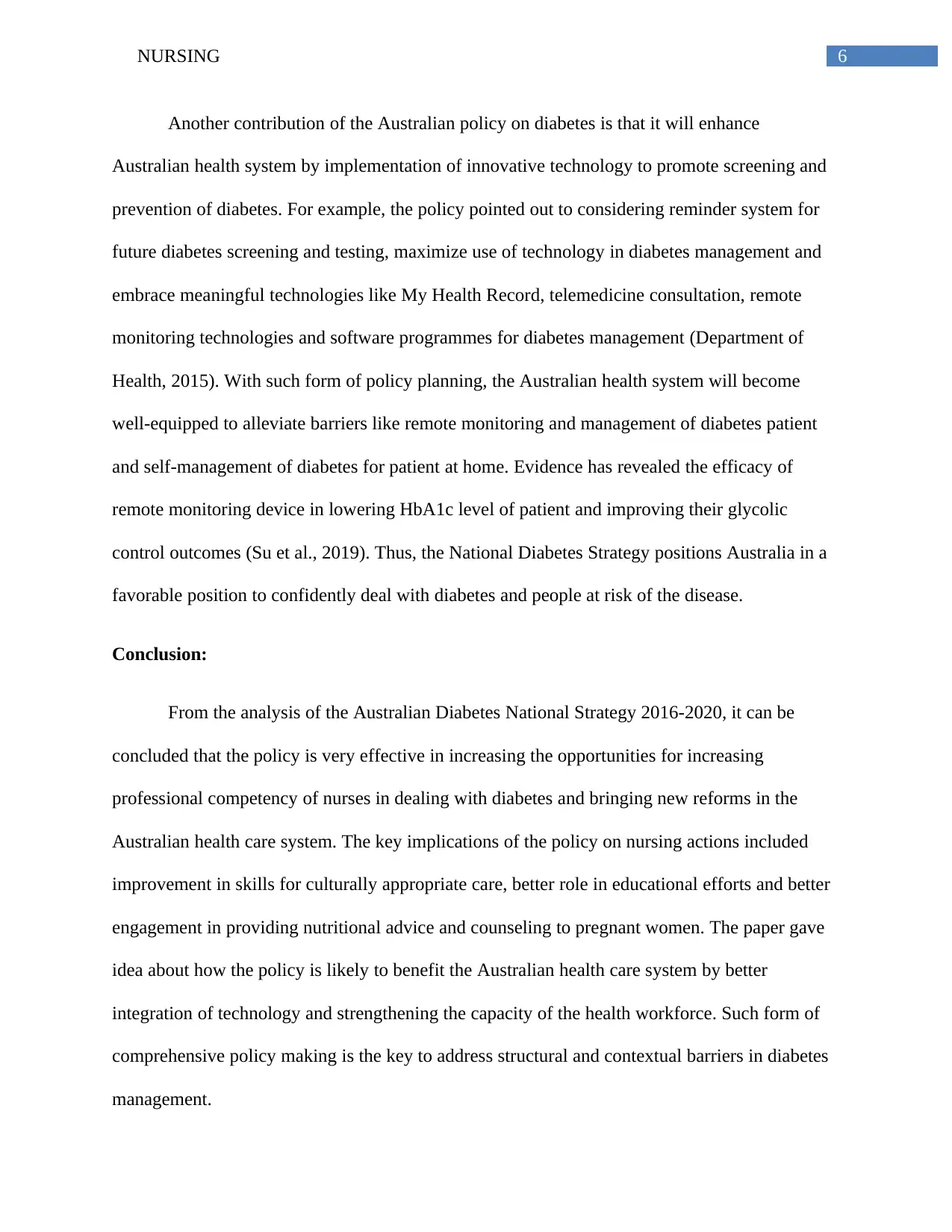
6NURSING
Another contribution of the Australian policy on diabetes is that it will enhance
Australian health system by implementation of innovative technology to promote screening and
prevention of diabetes. For example, the policy pointed out to considering reminder system for
future diabetes screening and testing, maximize use of technology in diabetes management and
embrace meaningful technologies like My Health Record, telemedicine consultation, remote
monitoring technologies and software programmes for diabetes management (Department of
Health, 2015). With such form of policy planning, the Australian health system will become
well-equipped to alleviate barriers like remote monitoring and management of diabetes patient
and self-management of diabetes for patient at home. Evidence has revealed the efficacy of
remote monitoring device in lowering HbA1c level of patient and improving their glycolic
control outcomes (Su et al., 2019). Thus, the National Diabetes Strategy positions Australia in a
favorable position to confidently deal with diabetes and people at risk of the disease.
Conclusion:
From the analysis of the Australian Diabetes National Strategy 2016-2020, it can be
concluded that the policy is very effective in increasing the opportunities for increasing
professional competency of nurses in dealing with diabetes and bringing new reforms in the
Australian health care system. The key implications of the policy on nursing actions included
improvement in skills for culturally appropriate care, better role in educational efforts and better
engagement in providing nutritional advice and counseling to pregnant women. The paper gave
idea about how the policy is likely to benefit the Australian health care system by better
integration of technology and strengthening the capacity of the health workforce. Such form of
comprehensive policy making is the key to address structural and contextual barriers in diabetes
management.
Another contribution of the Australian policy on diabetes is that it will enhance
Australian health system by implementation of innovative technology to promote screening and
prevention of diabetes. For example, the policy pointed out to considering reminder system for
future diabetes screening and testing, maximize use of technology in diabetes management and
embrace meaningful technologies like My Health Record, telemedicine consultation, remote
monitoring technologies and software programmes for diabetes management (Department of
Health, 2015). With such form of policy planning, the Australian health system will become
well-equipped to alleviate barriers like remote monitoring and management of diabetes patient
and self-management of diabetes for patient at home. Evidence has revealed the efficacy of
remote monitoring device in lowering HbA1c level of patient and improving their glycolic
control outcomes (Su et al., 2019). Thus, the National Diabetes Strategy positions Australia in a
favorable position to confidently deal with diabetes and people at risk of the disease.
Conclusion:
From the analysis of the Australian Diabetes National Strategy 2016-2020, it can be
concluded that the policy is very effective in increasing the opportunities for increasing
professional competency of nurses in dealing with diabetes and bringing new reforms in the
Australian health care system. The key implications of the policy on nursing actions included
improvement in skills for culturally appropriate care, better role in educational efforts and better
engagement in providing nutritional advice and counseling to pregnant women. The paper gave
idea about how the policy is likely to benefit the Australian health care system by better
integration of technology and strengthening the capacity of the health workforce. Such form of
comprehensive policy making is the key to address structural and contextual barriers in diabetes
management.
Paraphrase This Document
Need a fresh take? Get an instant paraphrase of this document with our AI Paraphraser
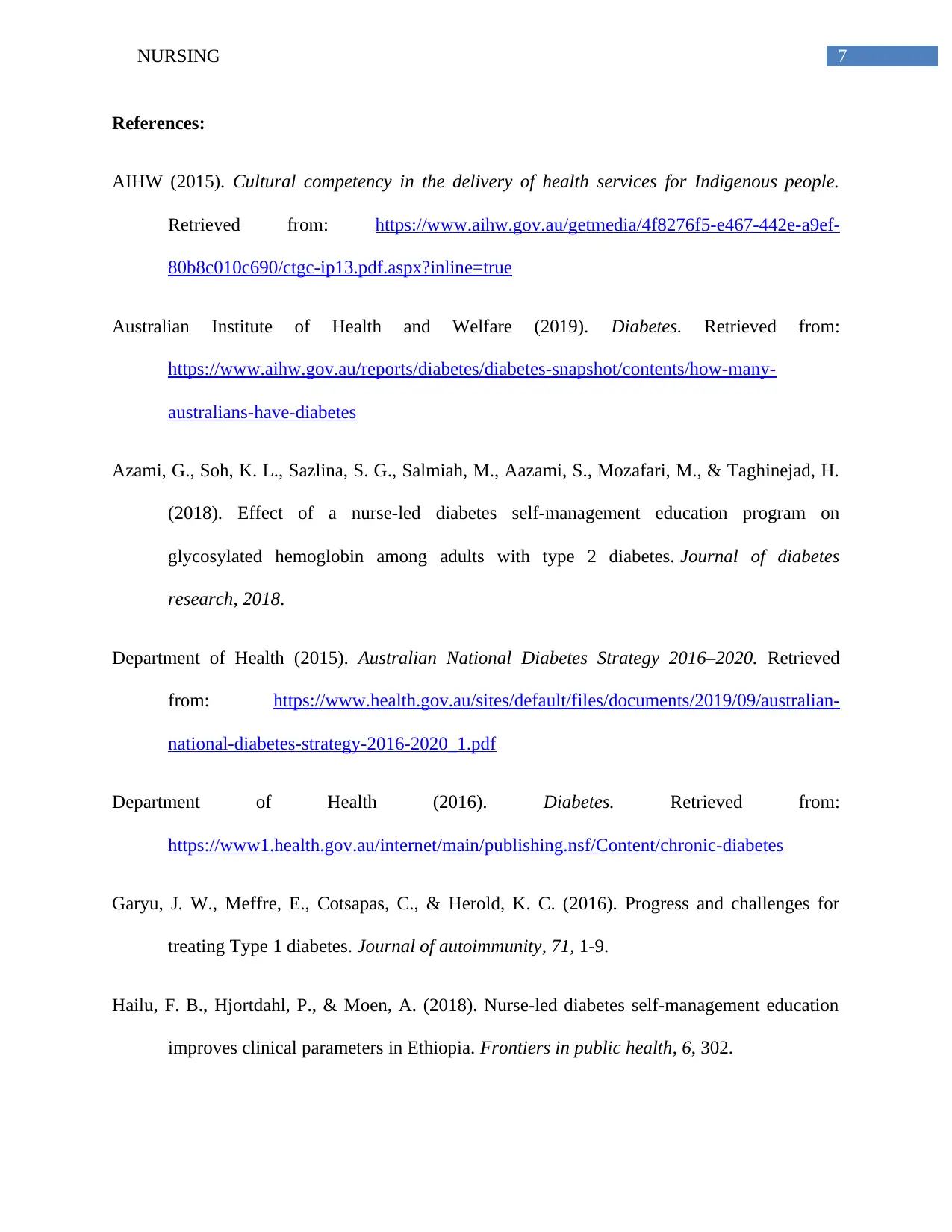
7NURSING
References:
AIHW (2015). Cultural competency in the delivery of health services for Indigenous people.
Retrieved from: https://www.aihw.gov.au/getmedia/4f8276f5-e467-442e-a9ef-
80b8c010c690/ctgc-ip13.pdf.aspx?inline=true
Australian Institute of Health and Welfare (2019). Diabetes. Retrieved from:
https://www.aihw.gov.au/reports/diabetes/diabetes-snapshot/contents/how-many-
australians-have-diabetes
Azami, G., Soh, K. L., Sazlina, S. G., Salmiah, M., Aazami, S., Mozafari, M., & Taghinejad, H.
(2018). Effect of a nurse-led diabetes self-management education program on
glycosylated hemoglobin among adults with type 2 diabetes. Journal of diabetes
research, 2018.
Department of Health (2015). Australian National Diabetes Strategy 2016–2020. Retrieved
from: https://www.health.gov.au/sites/default/files/documents/2019/09/australian-
national-diabetes-strategy-2016-2020_1.pdf
Department of Health (2016). Diabetes. Retrieved from:
https://www1.health.gov.au/internet/main/publishing.nsf/Content/chronic-diabetes
Garyu, J. W., Meffre, E., Cotsapas, C., & Herold, K. C. (2016). Progress and challenges for
treating Type 1 diabetes. Journal of autoimmunity, 71, 1-9.
Hailu, F. B., Hjortdahl, P., & Moen, A. (2018). Nurse-led diabetes self-management education
improves clinical parameters in Ethiopia. Frontiers in public health, 6, 302.
References:
AIHW (2015). Cultural competency in the delivery of health services for Indigenous people.
Retrieved from: https://www.aihw.gov.au/getmedia/4f8276f5-e467-442e-a9ef-
80b8c010c690/ctgc-ip13.pdf.aspx?inline=true
Australian Institute of Health and Welfare (2019). Diabetes. Retrieved from:
https://www.aihw.gov.au/reports/diabetes/diabetes-snapshot/contents/how-many-
australians-have-diabetes
Azami, G., Soh, K. L., Sazlina, S. G., Salmiah, M., Aazami, S., Mozafari, M., & Taghinejad, H.
(2018). Effect of a nurse-led diabetes self-management education program on
glycosylated hemoglobin among adults with type 2 diabetes. Journal of diabetes
research, 2018.
Department of Health (2015). Australian National Diabetes Strategy 2016–2020. Retrieved
from: https://www.health.gov.au/sites/default/files/documents/2019/09/australian-
national-diabetes-strategy-2016-2020_1.pdf
Department of Health (2016). Diabetes. Retrieved from:
https://www1.health.gov.au/internet/main/publishing.nsf/Content/chronic-diabetes
Garyu, J. W., Meffre, E., Cotsapas, C., & Herold, K. C. (2016). Progress and challenges for
treating Type 1 diabetes. Journal of autoimmunity, 71, 1-9.
Hailu, F. B., Hjortdahl, P., & Moen, A. (2018). Nurse-led diabetes self-management education
improves clinical parameters in Ethiopia. Frontiers in public health, 6, 302.
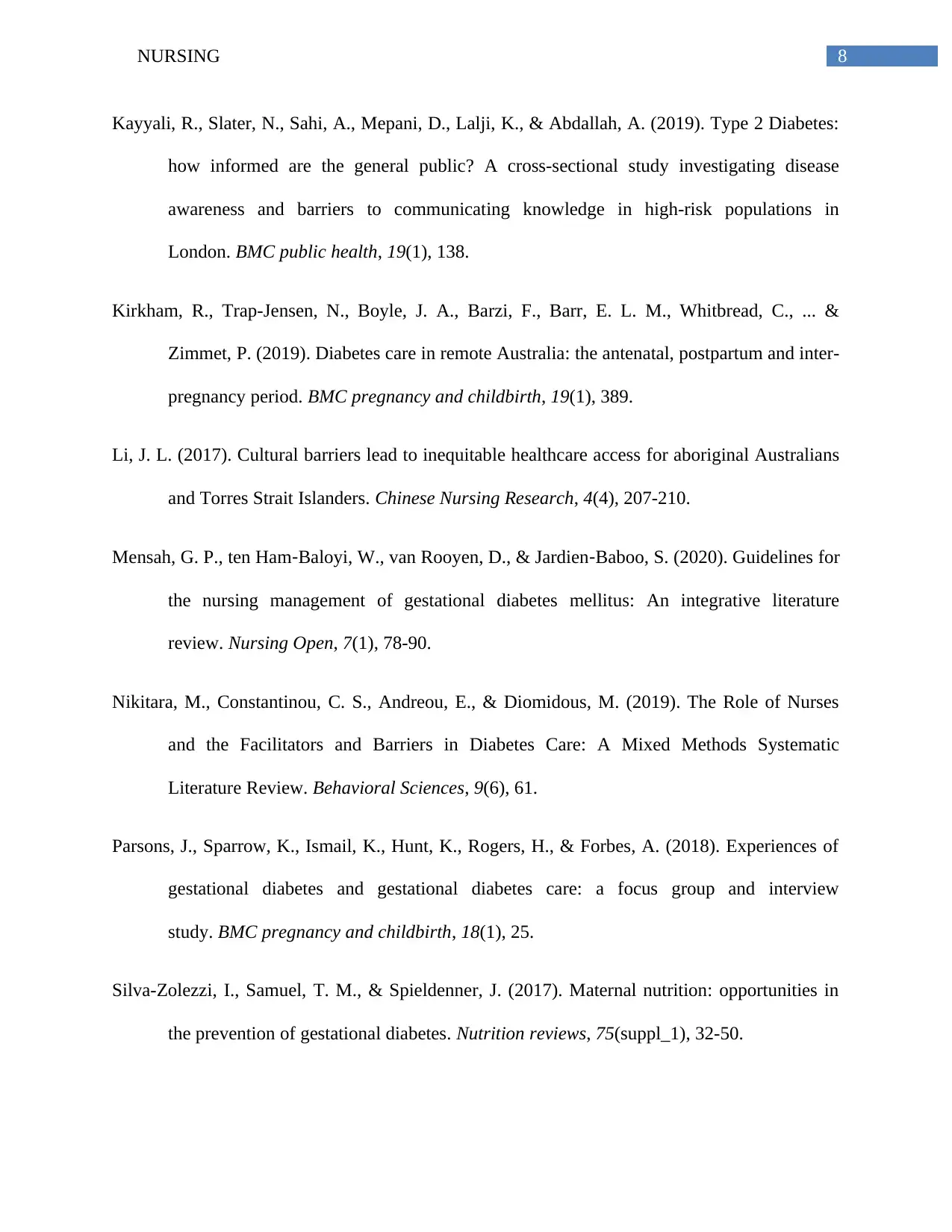
8NURSING
Kayyali, R., Slater, N., Sahi, A., Mepani, D., Lalji, K., & Abdallah, A. (2019). Type 2 Diabetes:
how informed are the general public? A cross-sectional study investigating disease
awareness and barriers to communicating knowledge in high-risk populations in
London. BMC public health, 19(1), 138.
Kirkham, R., Trap-Jensen, N., Boyle, J. A., Barzi, F., Barr, E. L. M., Whitbread, C., ... &
Zimmet, P. (2019). Diabetes care in remote Australia: the antenatal, postpartum and inter-
pregnancy period. BMC pregnancy and childbirth, 19(1), 389.
Li, J. L. (2017). Cultural barriers lead to inequitable healthcare access for aboriginal Australians
and Torres Strait Islanders. Chinese Nursing Research, 4(4), 207-210.
Mensah, G. P., ten Ham‐Baloyi, W., van Rooyen, D., & Jardien‐Baboo, S. (2020). Guidelines for
the nursing management of gestational diabetes mellitus: An integrative literature
review. Nursing Open, 7(1), 78-90.
Nikitara, M., Constantinou, C. S., Andreou, E., & Diomidous, M. (2019). The Role of Nurses
and the Facilitators and Barriers in Diabetes Care: A Mixed Methods Systematic
Literature Review. Behavioral Sciences, 9(6), 61.
Parsons, J., Sparrow, K., Ismail, K., Hunt, K., Rogers, H., & Forbes, A. (2018). Experiences of
gestational diabetes and gestational diabetes care: a focus group and interview
study. BMC pregnancy and childbirth, 18(1), 25.
Silva-Zolezzi, I., Samuel, T. M., & Spieldenner, J. (2017). Maternal nutrition: opportunities in
the prevention of gestational diabetes. Nutrition reviews, 75(suppl_1), 32-50.
Kayyali, R., Slater, N., Sahi, A., Mepani, D., Lalji, K., & Abdallah, A. (2019). Type 2 Diabetes:
how informed are the general public? A cross-sectional study investigating disease
awareness and barriers to communicating knowledge in high-risk populations in
London. BMC public health, 19(1), 138.
Kirkham, R., Trap-Jensen, N., Boyle, J. A., Barzi, F., Barr, E. L. M., Whitbread, C., ... &
Zimmet, P. (2019). Diabetes care in remote Australia: the antenatal, postpartum and inter-
pregnancy period. BMC pregnancy and childbirth, 19(1), 389.
Li, J. L. (2017). Cultural barriers lead to inequitable healthcare access for aboriginal Australians
and Torres Strait Islanders. Chinese Nursing Research, 4(4), 207-210.
Mensah, G. P., ten Ham‐Baloyi, W., van Rooyen, D., & Jardien‐Baboo, S. (2020). Guidelines for
the nursing management of gestational diabetes mellitus: An integrative literature
review. Nursing Open, 7(1), 78-90.
Nikitara, M., Constantinou, C. S., Andreou, E., & Diomidous, M. (2019). The Role of Nurses
and the Facilitators and Barriers in Diabetes Care: A Mixed Methods Systematic
Literature Review. Behavioral Sciences, 9(6), 61.
Parsons, J., Sparrow, K., Ismail, K., Hunt, K., Rogers, H., & Forbes, A. (2018). Experiences of
gestational diabetes and gestational diabetes care: a focus group and interview
study. BMC pregnancy and childbirth, 18(1), 25.
Silva-Zolezzi, I., Samuel, T. M., & Spieldenner, J. (2017). Maternal nutrition: opportunities in
the prevention of gestational diabetes. Nutrition reviews, 75(suppl_1), 32-50.
⊘ This is a preview!⊘
Do you want full access?
Subscribe today to unlock all pages.

Trusted by 1+ million students worldwide
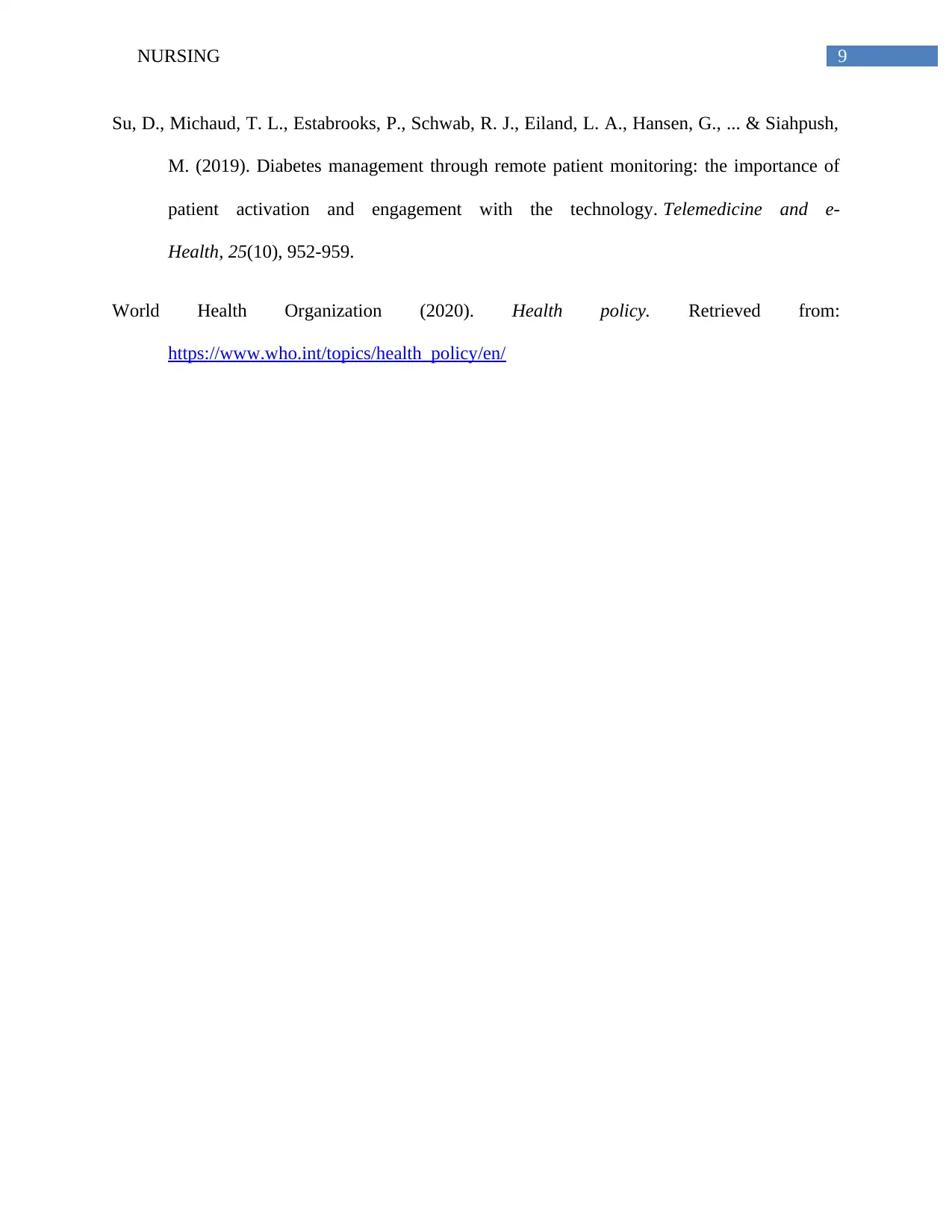
9NURSING
Su, D., Michaud, T. L., Estabrooks, P., Schwab, R. J., Eiland, L. A., Hansen, G., ... & Siahpush,
M. (2019). Diabetes management through remote patient monitoring: the importance of
patient activation and engagement with the technology. Telemedicine and e-
Health, 25(10), 952-959.
World Health Organization (2020). Health policy. Retrieved from:
https://www.who.int/topics/health_policy/en/
Su, D., Michaud, T. L., Estabrooks, P., Schwab, R. J., Eiland, L. A., Hansen, G., ... & Siahpush,
M. (2019). Diabetes management through remote patient monitoring: the importance of
patient activation and engagement with the technology. Telemedicine and e-
Health, 25(10), 952-959.
World Health Organization (2020). Health policy. Retrieved from:
https://www.who.int/topics/health_policy/en/
1 out of 10
Related Documents
Your All-in-One AI-Powered Toolkit for Academic Success.
+13062052269
info@desklib.com
Available 24*7 on WhatsApp / Email
![[object Object]](/_next/static/media/star-bottom.7253800d.svg)
Unlock your academic potential
Copyright © 2020–2025 A2Z Services. All Rights Reserved. Developed and managed by ZUCOL.





